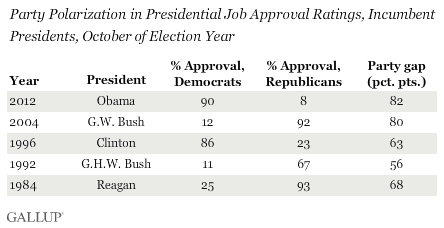PRINCETON, NJ -- Thus far in October, an average of 90% of Democrats, and 8% of Republicans, approve of the job Barack Obama is doing as president. That 82-percentage-point gap in approval ratings by party is on pace to be the largest Gallup has measured for a recent incumbent president in the final month before Americans vote on his re-election. George W. Bush had an 80-point party gap in approval, while the October gaps for other presidents were less than 70 points.

Gallup did not routinely ask presidential approval in October for presidents prior to Ronald Reagan. But Obama's ratings throughout his first three years in office have been among the most polarized Gallup has measured for any president.
Obama's already highly polarized ratings are becoming even more so in his fourth year in office. Thus far, his ratings have averaged 85% among Democrats and 10% among Republicans, for a 75-point gap. That compares with gaps averaging 68 points during his second and third years in office and 65 points during his first.
That is not unexpected, as Gallup has typically found presidents' ratings to be most polarized by party in their fourth year in office, which is normally the year they seek re-election to a second term. But ratings of recent presidents are far more politically divided than those of less recent presidents.
Obama's 75-point party gap in approval during year four to date is one point lower than the average 76-point gap for George W. Bush during his fourth year in office.

Bush's fourth year currently stands as the most polarized for any presidential year in Gallup records, dating back to 1953.
Reagan's presidency may have brought about the dawn of a more distinctly partisan view of presidents, which has continued and become more extreme, particularly with respect to George W. Bush and Obama.
Implications
Like his immediate predecessor, George W. Bush, President Obama gets near-universal approval from supporters of his own party and near-universal disapproval from supporters of the opposition party as he seeks re-election. Perhaps not coincidentally, both presidents had tough re-election battles, with Bush narrowly defeating John Kerry in 2004 and Obama trying to hold off Mitt Romney's strong challenge for his job this year.
That underscores the importance of turnout by the party groups in the Nov. 6 election, given that views of the president are largely fixed. Another key in determining Obama's electoral fate may be which side of the 50% approval mark independent voters wind up on; they have been very near 50% approval in recent weeks.
Explore President Obama's approval ratings in depth and compare them with those of past presidents in the Gallup Presidential Job Approval Center.
Survey Methods
Results are based on telephone interviews conducted as part of Gallup Daily election tracking survey Oct. 1-9, 2012, with a random sample of 4,558 adults, aged 18 and older, living in all 50 U.S. states and the District of Columbia.
For results based on the total sample of national adults, one can say with 95% confidence that the maximum margin of sampling error is ±1 percentage point.
Interviews are conducted with respondents on landline telephones and cellular phones, with interviews conducted in Spanish for respondents who are primarily Spanish-speaking. Each sample includes a minimum quota of 250 cell phone respondents and 250 landline respondents per 500 national adults, with additional minimum quotas among landline respondents by region. Landline telephone numbers are chosen at random among listed telephone numbers. Cell phone numbers are selected using random-digit-dial methods. Landline respondents are chosen at random within each household on the basis of which member had the most recent birthday.
Samples are weighted by gender, age, race, Hispanic ethnicity, education, region, adults in the household, population density, and phone status (cell phone only/landline only/both, cell phone mostly, and having an unlisted landline number). Demographic weighting targets are based on the March 2011 Current Population Survey figures for the aged 18 and older non-institutionalized U.S. population. All reported margins of sampling error include the computed design effects for weighting.
In addition to sampling error, question wording and practical difficulties in conducting surveys can introduce error or bias into the findings of public opinion polls.
For more details on Gallup's polling methodology, visit www.gallup.com.
